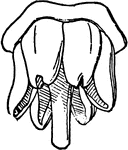Clipart tagged: ‘sporophyll’

Angiosperm
This illustration shows the flower and sporophylls of Angiosperms: 1, flower of Sedum with leaf-like…

Cycadeoid
"Cycadeoidea dacotensis. Semi-diagrammatic sketch of a flower (bisporangiate cone), cut longitudinally;…
